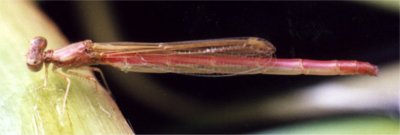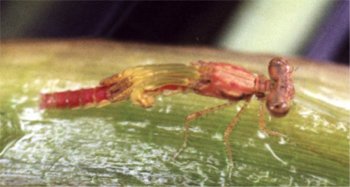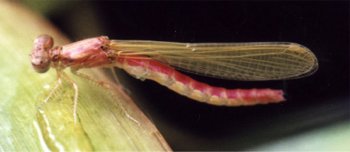Damselflies
by Valerie (July 15, 2000)

Our ponds are very attractive to insects with aquatic larval stages. We would probably be overrun with mosquitoes if it weren't for the voracious habits of damselfly and dragonfly larvae. The adults also prey on other insects.
There is one predominant species of damselfly that lives in our yard. It is called the desert firetail and the males are a brilliant red color while the females are brown. It is a very small damselfly, being only a little over an inch long, but when they are swarming around the water for mating and laying eggs, the color is very decorative. The larvae swim by wriggling back and forth, using their three-pronged tail to propel them through the water. They hatch out very tiny, but grow to about an inch long. They also start out being green and so match the water plants sufficiently to hide from larger predators. Later, they turn brown.
When they are ready for their final molt, they crawl up the sides of the pond or onto the plants and the skin over their back splits. The adult emerges with tiny wings and its abdomen all scrunched up. In a matter of minutes, the wings start to enlarge and the abdomen lengthens like a telescope. The color, especially on the red males, is at first rather pale, but it brightens, and freshly emerged adults are brilliant, with even their eyes being red. After a little longer, they darken a bit but are still a rather neon red color.
  |


